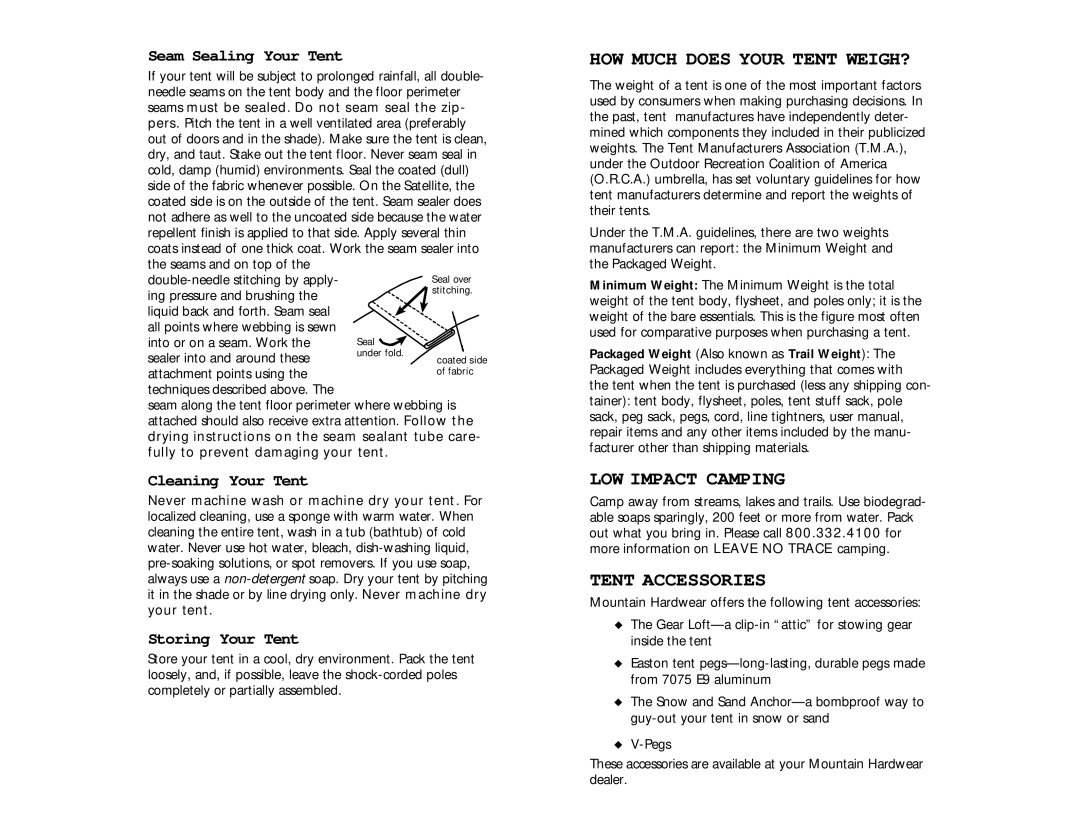
Seam Sealing Your Tent
If your tent will be subject to prolonged rainfall, all double- needle seams on the tent body and the floor perimeter seams must be sealed. Do not seam seal the zip- pers. Pitch the tent in a well ventilated area (preferably out of doors and in the shade). Make sure the tent is clean, dry, and taut. Stake out the tent floor. Never seam seal in cold, damp (humid) environments. Seal the coated (dull) side of the fabric whenever possible. On the Satellite, the coated side is on the outside of the tent. Seam sealer does not adhere as well to the uncoated side because the water repellent finish is applied to that side. Apply several thin coats instead of one thick coat. Work the seam sealer into the seams and on top of the
ing pressure and brushing the liquid back and forth. Seam seal
all points where webbing is sewn into or on a seam. Work the sealer into and around these
attachment points using the techniques described above. The
seam along the tent floor perimeter where webbing is attached should also receive extra attention. Follow the drying instructions on the seam sealant tube care- fully to prevent damaging your tent.
Cleaning Your Tent
Never machine wash or machine dry your tent. For
localized cleaning, use a sponge with warm water. When cleaning the entire tent, wash in a tub (bathtub) of cold water. Never use hot water, bleach,
your tent.
Storing Your Tent
Store your tent in a cool, dry environment. Pack the tent loosely, and, if possible, leave the
HOW MUCH DOES YOUR TENT WEIGH?
The weight of a tent is one of the most important factors used by consumers when making purchasing decisions. In the past, tent manufactures have independently deter- mined which components they included in their publicized weights. The Tent Manufacturers Association (T.M.A.), under the Outdoor Recreation Coalition of America (O.R.C.A.) umbrella, has set voluntary guidelines for how tent manufacturers determine and report the weights of their tents.
Under the T.M.A. guidelines, there are two weights manufacturers can report: the Minimum Weight and the Packaged Weight.
Minimum Weight: The Minimum Weight is the total weight of the tent body, flysheet, and poles only; it is the weight of the bare essentials. This is the figure most often used for comparative purposes when purchasing a tent.
Packaged Weight (Also known as Trail Weight): The Packaged Weight includes everything that comes with the tent when the tent is purchased (less any shipping con- tainer): tent body, flysheet, poles, tent stuff sack, pole sack, peg sack, pegs, cord, line tightners, user manual, repair items and any other items included by the manu- facturer other than shipping materials.
LOW IMPACT CAMPING
Camp away from streams, lakes and trails. Use biodegrad- able soaps sparingly, 200 feet or more from water. Pack out what you bring in. Please call 800.332.4100 for more information on LEAVE NO TRACE camping.
TENT ACCESSORIES
Mountain Hardwear offers the following tent accessories:
◆The Gear
◆Easton tent
◆The Snow and Sand
◆
These accessories are available at your Mountain Hardwear dealer.
